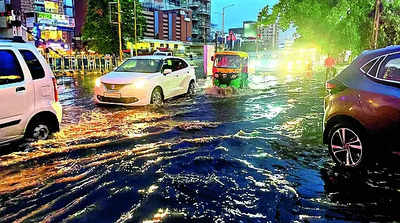- News
- City News
- chennai News
- TN 2050: Wet, sweat, go!
Trending
TN 2050: Wet, sweat, go!
In Tamil Nadu, the increasing heatwave days and urbanisation are driving up temperatures, necessitating a focus on green spaces and climate risk assessments for effective heat mitigation strategies.

Projections by researchers at the Centre for Climate Change and Disaster Management (CCCDM) at Anna University say by 2050, the average maximum temperature may rise by 0.4°C. By 2080, it will hit 1.3°C and by 2100, see a 1.7°C spike. The projections will be applicable in a climate change scenario where CO2 emissions remain near the current levels but decline mid-century. In the worst-case scenario, the temperature may rise by 0.6°C in another 25 years, 2°C by 2080 and 3.6°C by 2100.
Northern districts of Chennai, Tiruvallur, Kancheepuram, Vellore, Chengalpet, and Ranipet are expected to experience more intense heat. Chennai, Tirunelveli, Thoothukudi, and Thanjavur will likely see a doubling of heatwave days. A heatwave is declared when temperatures rise about 4.5°C above normal Chennai will be the most affected with an increase from 42 days between 1985 and 2014 to 81 days between 2021 and 2050. Thermal discomfort days may also rise to about 250 days a year.
The reports ‘Climate Profile and Projections of Tamil Nadu- Climate Modelling’ and ‘Climate Risk Assessment and Adaptation Plan of Tamil Nadu – Sustainable Habitat’ say the temperature rise and prolonged dry spells will lead to heatwaves and discomfort, particularly in urban areas. Coastal districts may see intense rainfall within short periods, rather than uniformly throughout the monsoon season”.
For 30 years till 2014, the average day temperature in state ranged between 29.5°C and 33.4°C and the average rainfall between 763mm and 1432mm. Chennai, Kancheepuram, Chengalpet, Tiruvallur, Tiruvarur and Cuddalore recorded the average highest temperature and rainfall.
“The difference in the temperature profile across TN is due to geographical location in relation to the equator, altitude, land use, urbanisation and wind and monsoon patterns,” says Kurian Joseph, director of CCCDM.
Cities in northern coastal regions such as Greater Chennai Corporation, Avadi and Tambaram are exposed to high levels of climate hazards. Tirunelveli, Trichy, Thanjavur, Kumbakonam, Madurai, Sivakasi, Dindigul, Nagercoil, Kancheepuram, Tuticorin, Cuddalore and Salem are at moderate risk, and Karur, Tiruppur, Hosur, Coimbatore, Erode and Vellore at low risk.
“The rise in heatwave days in northern TN may stem from the expanding heatwave belt from Telangana, Andhra Pradesh, and Odisha,” says Professor Krishna AchutaRao of IIT Delhi. “Urbanisation reduces green cover, creating urban heat islands, and global warming exacerbates this. Filling water bodies for construction contributes to higher temperatures. Global phenomena like El Nino and La Nina also influence the region, including TN.”
Former IMD deputy director general Y E A Raj says urbanisation has also made nights warmer in cities since the 1970s as temperatures do not dip below 18°C.
It’s going to get wetter too. Rainfall may increase by up to 4% by 2050, 11% by 2080, and 16% by 2100 if emissions decline by 2050. In a worst-case scenario, rainfall could rise by 7% by 2050 and 26% by 2100. Cuddalore, Nagapattinam, and Mayiladuthurai will see the most changes, with intense rainfall days (6cm or more in 24 hours) increasing from four to seven per year by century’s end. “Intense rainfall signals climate change,” says Joseph. “Warmer sea temperatures increase evaporation, causing clouds to hold more water vapour, intensifying rainfall.”
The reports say 16 of 21 TN cities lack sufficient green cover as per urban greening guidelines. Chennai, with the lowest at 8sqkm (2%), needs an additional 71sqkm but faces a 62sqkm shortfall in open spaces. Coimbatore has 7sqkm of green cover, requiring 53sqkm more, with a 40sqkm deficiency. Nagercoil boasts the highest urban green cover at 20%. Cities with the least green cover also have the most built-up areas.
Chennai saw a threefold increase in built-up area from 1991 to 2021. As per the urban greening guidelines 2014, the ministry recommends that the proportion of recreational areas (parks, spaces, water bodies, etc) to the total developed area in medium towns and large cities should be between 18% and 20% and 20%-25% in metropolitan cities.
At a recent conference on heatwaves and changing monsoon patterns, Supriya Sahu, secretary of environment, climate change, and forest, announced that the state is drafting a policy to improve urban green cover. “A portal is being developed to train residents’ welfare associations to tackle heatwaves. TN is the most urbanised state in India, which is why heat mitigation needs to be addressed urgently. A small increase in heat can adversely impact quality of life,” said Sahu.
End of Article
FOLLOW US ON SOCIAL MEDIA










